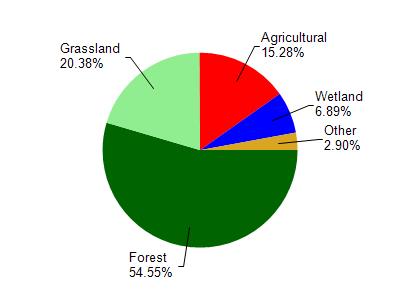Iowa
No
No
Yes
Fish and Aquatic Life
Overview
Ryan Hollow Creek (Knights Hollow Creek) - Ryan Hollow Creek is a small spring fed tributary to Mill Creek in Iowa County. The creek currently is thought to support a cold water forage fishery, but the creek may have some potential to support a Class II trout fishery. The stream receives much of its flow from White Hollow Creek. Ryan Hollow Creek has been extensively modified by erosion control dams and the creek has some habitat problems. There is limited access to Ryan Hollow Creek.
From: Ripp, Coreen, Koperski, Cindy and Folstad, Jason. 2002. The State of the Lower Wisconsin River Basin.
PUBL WT-559-2002. Wisconsin Department of Natural Resources, Madison, WI.
Date 2002
Author Cynthia Koperski
Historical Description
Ryan Creek is a Class II trout stream (WDNR, 1980). Cattle access to the stream has
created significant erosion problems affecting in-stream habitat (Day, 1985). No recent
water resources monitoring has been done on this stream.
Date 1994
Author Surface Water Inventory Of Wisconsin
Historical Description
Ryan Hollow Creek - Mouth location T8N R5E Section 4 -14, Surface area = 1.9 acres, Length = 3.2 miles, Gradient = 31.4 feet per mile, Total alkalinity = 238 mg/l, Volume of flow = 0.9 cfs.
Ryan Creek is a small spring fed tributary to Mill Creek. It has a moderate gradient and flows through a fairly wide valley which helps to curb flooding and serious bank erosion. In addition, there are at least four erosion control dams in its watershed. White Hollow is its only tributary, contributing about one-third its base flow. Although this stream has good
water quality the lack of sufficient volume and pools eliminates the possibility of a sport fishery. Seining surveys show that there is a forage fish population which includes creek chubs, brassy minnows, bigmouth shiners and johnny darters. Lack of water area limits game assets to some muskrats at its mouth. There are no public lands but it is accessible from two town roads and one county road.
From: Piening, Ronald and Threinen, C.W., 1968. Lake and Stream Classification Project. Surface Water Resources of Iowa County, Wisconsin Department of Natural Resources, Madison, WI.
Date 1968
Author Surface Water Inventory Of Wisconsin
Condition
Wisconsin has over 84,000 miles of streams, 15,000 lakes and milllions of acres of wetlands. Assessing the condition of this vast amount of water is challenging. The state's water monitoring program uses a media-based, cross-program approach to analyze water condition. An updated monitoring strategy (2015-2020) is now available. Compliance with Clean Water Act fishable, swimmable standards are located in the Executive Summary of Water Condition in 2018. See also the 'monitoring and projects' tab.
Reports
Management Goals
Wisconsin's Water Quality Standards provide qualitative and quantitative goals for waters that are protective of Fishable, Swimmable conditions [Learn more]. Waters that do not meet water quality standards are considered impaired and restoration actions are planned and carried out until the water is once again fishable and swimmable
Management goals can include creation or implementation of a Total Maximum Daily Load analysis, a Nine Key Element Plan, or other restoration work, education and outreach and more. If specific recommendations exist for this water, they will be displayed below online.
Monitoring
Monitoring the condition of a river, stream, or lake includes gathering physical, chemical, biological, and habitat data. Comprehensive studies often gather all these parameters in great detail, while lighter assessment events will involve sampling physical, chemical and biological data such as macroinvertebrates. Aquatic macroinvertebrates and fish communities integrate watershed or catchment condition, providing great insight into overall ecosystem health. Chemical and habitat parameters tell researchers more about human induced problems including contaminated runoff, point source dischargers, or habitat issues that foster or limit the potential of aquatic communities to thrive in a given area. Wisconsin's Water Monitoring Strategy was recenty updated.
Grants and Management Projects
| Project Name (Click for Details) | Year Started |
|---|
|
|
Monitoring Projects
| WBIC | Official Waterbody Name | Station ID | Station Name | Earliest Fieldwork Date | Latest Fieldwork Date | View Station | View Data |
|---|
| 1242500 | Ryan Creek | 253075 | Knight Hollow - Above Mini-Confluence | | | Map | Data |
| 1242500 | Ryan Creek | 10051105 | Ryan Creek US CTH H | 6/8/2018 | 6/8/2018 | Map | Data |
| 1242500 | Ryan Creek | 253074 | Knight Hollow - Above Conf. North | | | Map | Data |
| 5035050 | Unnamed | 253072 | Knight Hollow Trib - Roberts Farm | | | Map | Data |
| 1242500 | Ryan Creek | 10051104 | Ryan Creek US CTH HH | 6/8/2018 | 10/31/2023 | Map | Data |
|

Watershed Characteristics
Ryan Creek is located in the Mill and Blue Mounds Creek watershed which is 186.74 mi². Land use in the watershed is primarily forest (54.60%), grassland (20.40%) and a mix of agricultural (15.30%) and other uses (9.80%). This watershed has 382.87 stream miles, 106.91 lake acres and 6,596.99 wetland acres.
Nonpoint Source Characteristics
This watershed is ranked Medium for runoff impacts on streams, Low for runoff impacts on lakes and High for runoff impacts on groundwater and therefore has an overall rank of High. This value can be used in ranking the watershed or individual waterbodies for grant funding under state and county programs.However, all waters are affected by diffuse pollutant sources regardless of initial water quality. Applications for specific runoff projects under state or county grant programs may be pursued. For more information, go to surface water program grants.